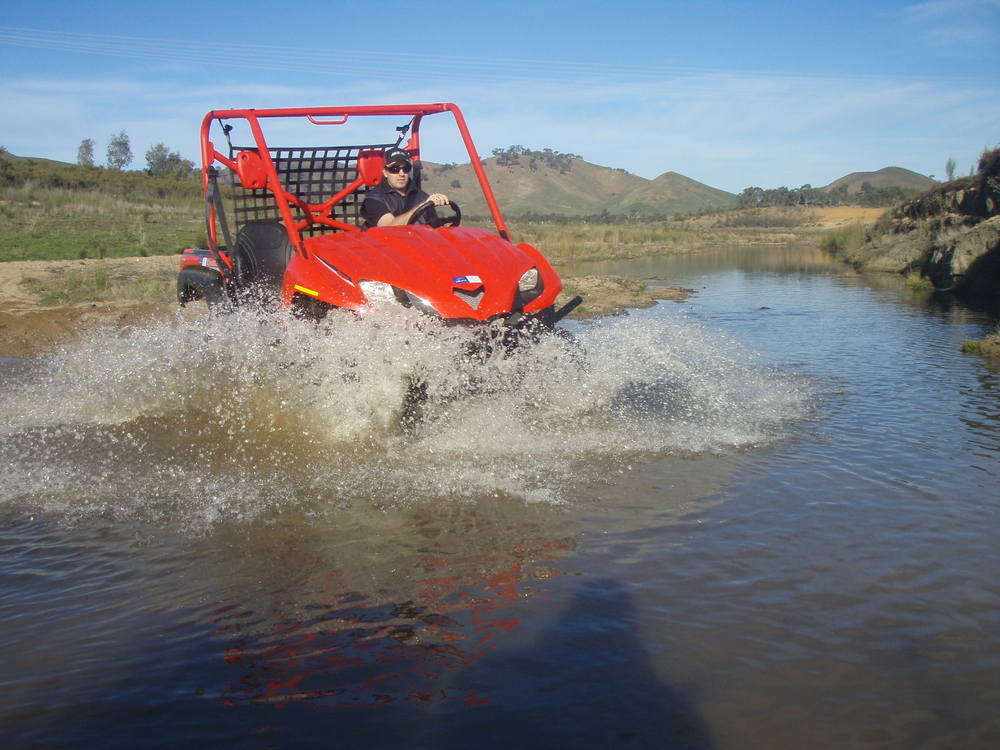The History of Side-By-Sides: From Farm Buggies to Recreational Must-Haves
November 23rd, 2023

Side-by-side vehicles have long served as multipurpose vehicles across various industries and uses, but just how far back does its history go?
Whether you know them as UTVs (Utility Task Vehicles), off-road vehicles, or simply buggies, side-by-sides have become a staple used in off-road adventures and outdoor recreation. These versatile machines have a history that dates back to World War II.
But before our history lesson, let’s take a step back and define side-by-sides.
What is a Side-by-Side Utility Vehicle?
Side-by-side vehicles (SSV) are a type of off-road vehicle with a minimum of two seats positioned side by side and enclosed with a cage structure. These vehicles have steering wheels and foot controls for operation and have a minimum of four wheels.

SSVs are called by many names. Here are some of the popular ones:
- Multipurpose Off-Highway Utility Vehicles (MOHUV)
- Utility Vehicle
- Utility Task Vehicle (UTV)
- Ultra-Terrain Vehicle (UTV)
- Unlimited Terrain Vehicle (UTV)
- Off-Road vehicle (ORV)
- Off-Highway Vehicle (OHV)
- Recreational Utility Vehicle (RUV)
- Recreational Off-Road Vehicle
- Side-by-Side (SXS)
Since its humble beginnings, SSVs have become popular workhorses in agriculture, mining, and events. But how have these buggies evolved since their inception?
The First Side By Sides: 1940s - 1950s
SSVs have evolved from many influencing off-road vehicles, which explains the multiple names they’re given! The first recorded off-road vehicles were seen in World War II, although they were not known as side-by-side vehicles then.
The first mass-produced off-roaders were Jeeps in 1942. Known as the Willys Quad, these Jeeps were created due to a demand from the U.S. Army for a 1/4 ton "light reconnaissance vehicle." Although SSVs have evolved from the humble Jeep, we can see how the first off-roader has influenced the vehicles we ride today.
The early Jeeps, while functional in the military, were too heavy for other uses - which prompted the creation of dune buggies in the 1960s.
Exploring Its Uses: 1960s - 1970s
The surfing lifestyle was trendy in the 60s and 70s, and a buggy was needed to get a better range across sands. The first popularised dune buggy was the Meyers Manx, made by Bruce Meyers from 1964 to 1971. Unlike the Jeeps, dune buggies are built with a lighter base frame with an open-top design - making them easier to handle in open sand.
The 1960s also saw the rise of ATVs. The first ATV was the Jiger ATV, a 6-wheel drive, all-terrain, fully amphibious vehicle originating from Canada. The original Jiger was used for work and adventure, but sales were slow due to a niche market and a higher price point.
This wasn’t to say that the ATV was a failed product. Thanks to its lower fuel consumption than tractors, it was highly popular among farmers who used it as farm buggies. One could even say that ATVs influenced the design of SSVs today and paved the way for an affordable utility off-road vehicle in the 1980s.
The Rise of Side-By-Sides: 1980s
By the 1980s, consumers were familiar with the multiple uses of off-road vehicles, and a demand was there for a powerful workhorse that could combine both. In 1982, Japanese car manufacturer Suzuki developed the first ever 4-wheel UTV, the Kawasaki MULE (Multi-Use Light Equipment), which was a unique combination of a truck and an ATV.
With a deadly combination of versatility, functionality, and power, the MULE shot to fame among individuals and businesses. The MULE was widely used in the agriculture and commercial sectors for carrying heavier loads and going about with ease.
Until today, the Kawasaki MULE is an iconic vehicle that pioneered the agriculture industry and became a standard for many SSVs to follow. It’s also the off-road vehicle that kickstarted 1800BUGGIES, being the first set of UTVs purchased as our utility vehicles for hire.
The Fun Begins - 2000s
One of the earliest UTVs designed for work and recreational use was the Yamaha Rhino in 2004. With a smaller design and a larger cargo bed, it was a great vehicle for multiple uses, paving the way for users looking for both work and play.
Another notable vehicle in this space is the Polaris RZR in 2007, a UTV with a smaller width that made it the first for trail riding. Kawasaki also launched its Teryx 750 4x4 in 2008 as a response to the demand for RUVs (Recreation Utility Vehicles).

The Future of UTVs
SSVs have come a long way since the first Jeep, but there’s the promise of more changes as they adapt to industry demands.
We’ll continue to see the rise of farm UTVs with the implementation of a law that requires all ATVs to be fitted with an ‘Operator Protective Device’ (OPD) - making the market unattractive for ATV manufacturers. Additionally, the load-carry functionality of an SSV also makes it more attractive to many farmers and workers.
UTV safety is also another aspect that will continue to see growth, as manufacturers and retailers will be pushed to ensure users are using the right SSV for their needs. Safety training will become more critical as more users find value in these amazing vehicles.
SSV rentals are also gaining momentum as businesses, farmers, and event organisers realise the cost savings in hiring a buggy. A company like 1800BUGGIES is Australia’s largest rental fleet of ATVs and other utility vehicles, providing businesses with side-by-sides for hire, including the Kawasaki MULE, Polaris Ranger Crew, UTVs and Medical Mules.
For more information on our side-by-side vehicles for hire, contact our team.
